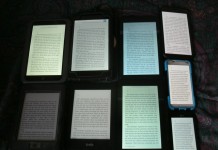 If you love e-books and want to help children in developing countries, then this news is for you. The One Laptop per Child project hopes to sell its green-and-white laptop over the Net to consumers by Christmas, according to Reuters.
If you love e-books and want to help children in developing countries, then this news is for you. The One Laptop per Child project hopes to sell its green-and-white laptop over the Net to consumers by Christmas, according to Reuters.
The OLPC screens are high-contrast in the nonbacklit mode, just like E Ink, even though the technology is different. And the possible $350 price for consumers could help subsidize the cost of the $175 machine for developing countries.
Of interest, too, the laptop can convert to a tablet—which many will prefer for e-book reading. Also, most likely, it’s more rugged than the current crop of E Ink machines.
$350, not $525, please
Alas, Mary Lou Jepsen, OLPC’s CTO, says the consumer price might actually reach $525 instead. How’s that for a little coal in your stocking? But $350 would seem to be a sweet spot, and I hope that this possibility isn’t just hot air.
So, gang, would you take advantage of the offer? And if OLPC’s hopes pan out, just how do you think the e-book industry should prepare? The guys over at OSoft would love to get dotReader on the OLPC machine, which would mean it could read books in the new IPDF format. And how about Adobe and Mobipocket and eReader and VitalSource? I take it for granted that if they see the market as big enough, they would harbor similar hopes.
OLPC and traditional publishing models
Another interesting question is what attitude OLPC will take toward providers of commercial e-books and other content developed through traditional business models. I’d hope OLPC would be supportive. This is a chance to give e-publishing a kick start not just in the states but also in developing countries, where the usual libraries and bookstores often are rarities.
The Creative Commons approach, typically offering consumers free access to content for noncommercial purposes, is useful. But it’s hardly the solution for every book, especially in situations where commercial print-on-demand books, promoted by the freebies, would be just too much trouble.
Recommended reading: OLPC News’ account, including speculation on what this could mean to the usual hardware producers now gearing up for Christmas sales. And, OLPC News wonders, how about distribution? Will eBay or even the besieged CompUSA handle it?


































Sorry, but no thanks. At $525US the OLPC is just a very expensive toy like most of the ereaders out there (except the $99 Sony Reader =). Reality bites. We were grossly misled about the pricing and that leaves a bad taste in my mouth about the whole OLPC project.
Wow, talk about timing! I just blogged about OLPC a few days ago (http://beagley.livejournal.com).
If they cost $200, I would buy 2 of them. At $375, I would probably buy one. At $525, I would look at them longingly and whine a lot… I would need to play with one for a while before committing.
This looks to be a WONDERFUL e-reader device, and with the open source OS and endless hackability, every feature we can dream up is possible (except for touch screen paragraph highlighting, of course).
At $375, I might make the OLPC my primary laptop.
What’s with the bright green? The primary rule for an ebook reader should be that its appearance does not distract one from the page display.
–Mike
http://www.michaelabanks.com
Mike, I absolutely agree with you about the green. To get the most out of the new WordPress, we had to ditch our old WordPress theme, which was customized. I’d like to darken the green and otherwise bring back some of the old characteristics. Somewhat larger fonts would also help, in my opinion, although this will be a joint decision with Robert Nagle. The restoration o of the old TeleRead flag at the top would also help. Keep the feedback coming! Big thanks. David
I thought MAB was perhaps talking about the glare of the OLPC screen.
There are two purposes for a OLPC device here that should probably not be confused. One is as a generic ultra-mobile laptop. These devices typically sell for thousands of dollars a piece — if you call the MacBook an ultra-mobile, it’s probably the cheapest at around 1000 USD. The other is as an e-book reader. I am guessing that the 525 USD price was thought up with the former use in mind. The OLPC would be a competitor to the Asus EEE, which is a lot cheaper, but which also has a worse screen and is far less energy efficient.
The device cannot compete with e-book readers, which typically already have a good screen and are energy efficient at a far lower price. Which is a pity, but you can hardly fault MIT for not veering off their path just to accommodate a few e-book fans.